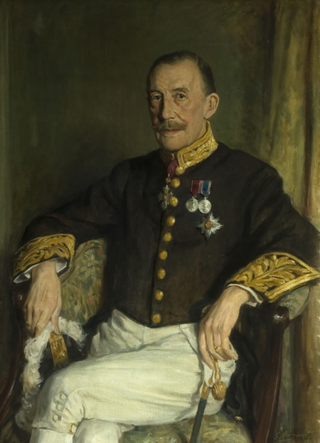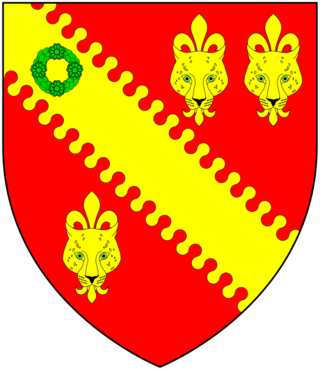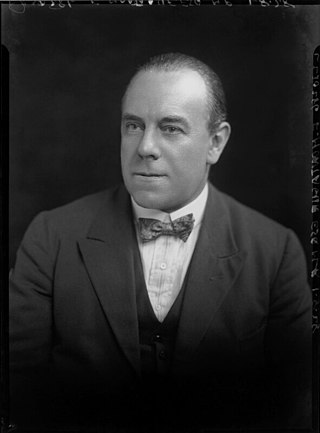
Viscount Trenchard, of Wolfeton in the County of Dorset, is a title in the Peerage of the United Kingdom. It was created in 1936 for Marshal of the Royal Air Force, Hugh Trenchard, 1st Baron Trenchard. He had already been created a Baronet, of Wolfeton in the County of Dorset, in the Baronetage of the United Kingdom in 1919 and Baron Trenchard, of Wolfeton in the County of Dorset, in 1930, also in the Peerage of the United Kingdom. His second son, the second Viscount, held junior ministerial positions from 1979 to 1983 in the Conservative administration of Margaret Thatcher. As of 2018 the titles are held by the latter's son, the third Viscount, who succeeded in 1987. In 2004 he replaced the recently deceased Lord Vivian as one of the ninety elected hereditary peers that are allowed to remain in the House of Lords after the passing of the House of Lords Act 1999. Lord Trenchard sits on the Conservative benches.
Viscount Allendale, of Allendale and Hexham in the County of Northumberland, is a title in the Peerage of the United Kingdom. It was created on 5 July 1911 for the Liberal politician Wentworth Beaumont, 2nd Baron Allendale. The title of Baron Allendale, of Allendale and Hexham in the County of Northumberland, had been created in the Peerage of the United Kingdom on 20 July 1906 for his father, the Yorkshire mining magnate and Liberal Member of Parliament, Wentworth Beaumont. The first Viscount's son, the second Viscount, notably served as Lord Lieutenant of Northumberland between 1949 and 1956. As of 2017 the titles are held by the latter's grandson, the fourth Viscount, who succeeded his father in 2002.
Baron Ventry, of Ventry in the County of Kerry, is a title in the Peerage of Ireland. It was created in 1800 for Sir Thomas Mullins, 1st Baronet. He had already been created a Baronet, of Burnham in the County of Kerry, in the Baronetage of Ireland in 1797. The Mullins family claimed descent from the Norman De Moleyns family. The first Baron's grandson, the third Baron, resumed the alleged 'ancient' family name of De Moleyns by Royal licence in 1841. His son, the fourth Baron, sat in the House of Lords as an Irish Representative Peer from 1871 to 1914. Lord Ventry also assumed the additional surname of Eveleigh, which was that of an earlier ancestor. His younger son, the sixth Baron, married Evelyn Muriel Stuart Daubeny. As of 2014 the titles are held by their grandson, the eighth Baron, who succeeded his uncle in 1987. In 1966 he assumed by deed poll the surname of Daubeney de Moleyns.

Baron Faringdon, of Buscot Park in the County of Berkshire, is a title in the Peerage of the United Kingdom. It was created in 1916 for Sir Alexander Henderson, 1st Baronet, who had previously represented Stafford West and St George's, Hanover Square in the House of Commons as a Liberal Unionist. He had already been created a baronet in 1902. He was succeeded by his grandson, the second Baron. He was the son of the Hon. Harold Henderson, eldest son of the first Baron, who predeceased his father. Lord Faringdon was a member of the London County Council. As of 2017 the titles are held by his nephew, the third Baron, who succeeded in 1977. He is the son of the Hon. Michael Thomas Handerson, second son of the Hon. Harold Henderson.

Baron Hemingford, of Watford in the County of Hertford, is a title in the Peerage of the United Kingdom. It was created 1 February 1943 for the Conservative politician Sir Dennis Herbert. He was a Deputy Speaker of the House of Commons from 1931 to 1943. His son, the second Baron, notably served as Lord Lieutenant of Huntingdon and Peterborough from 1968 to 1974. The title is currently held by Christopher Herbert, who succeeded in 2022.
Baron de Ramsey, of Ramsey Abbey in the County of Huntingdon, is a title in the Peerage of the United Kingdom. It was created in 1887 for Edward Fellowes, who had previously represented Huntingdonshire in the House of Commons as a Conservative for 43 years. His eldest son, the second Baron, sat as Member of Parliament for Huntingdonshire and Ramsey and later served as a Lord-in-waiting from 1890 to 1892 in the Conservative administration of Lord Salisbury. His grandson, the third Baron, was Lord Lieutenant of Huntingdonshire from 1947 to 1965 and of Huntingdon and Peterborough between 1965 and 1968. As of 2017 the title is held by the latter's son, the fourth Baron, who succeeded in 1993.
Baron Kindersley, of West Hoathly in the County of Sussex, is a title in the Peerage of the United Kingdom. It was created in 1941 for the businessman Sir Robert Kindersley, chiefly in recognition of his work as President of the National Savings Committee. His second son, the second Baron, was a Brigadier in the Scots Guards. As of 2017 the title is held by the latter's grandson, the 4th Baron, who succeeded his father in 2013.
Baron Killearn, of Killearn in the County of Stirling, is a title in the Peerage of the United Kingdom. It was created in 1943 for the diplomat Sir Miles Lampson. He was the second son of Norman Lampson, youngest son of Sir Curtis Lampson, 1st Baronet, of Rowfant. Lord Killearn's eldest son, the second Baron, succeeded his second cousin once removed as fourth Baronet in 1971. On his death the titles passed to his half-brother, the third and present holder of the barony and baronetcy.
Baron Kershaw, of Prestwich in the County Palatine of Lancaster, is a title in the Peerage of the United Kingdom. It was created in 1947 for Fred Kershaw, who later served as a Lord-in-waiting in the Labour government of Clement Attlee. As of 2010 the title is held by his grandson, the fourth Baron, who succeeded his father in 1962.

Baron Newall, of Clifton-upon-Dunsmoor in the County of Warwick, is a title in the Peerage of the United Kingdom. It was created on 18 July 1946 for Marshal of the Royal Air Force Sir Cyril Newall. He was Chief of the Air Staff between 1937 and 1940 and Governor-General of New Zealand between 1941 and 1946. As of 2017 the title is held by his only son, the second Baron, who succeeded in 1963.
Baron Shepherd, of Spalding in the County of Lincoln, is a title in the Peerage of the United Kingdom. It was created in 1946 for George Shepherd, who had previously served as National Agent of the Labour Party. His only son, Malcolm Newton Shepherd, 2nd Baron Shepherd the second Baron, was also a prominent Labour politician and notably served as Leader of the House of Lords. After the House of Lords Act 1999 removed the automatic right of hereditary peers to sit in the House of Lords he was given a life peerage as Baron Shepherd of Spalding, of Spalding in the County of Lincolnshire. This enabled him to remain an active member of the House of Lords On his death in 2001 the life barony became extinct, while he was succeeded in the hereditary barony by his eldest son, Graeme, the third and present holder of the title.

Baron Parmoor, of Frieth in the County of Buckingham, is a title in the Peerage of the United Kingdom. It was created on 16 January 1914 for the lawyer and politician Sir Charles Cripps. He and his second wife, Marian Ellis, were anti-war activists. Two of his sons, the second and third Baron, both succeeded in the title. The third Baron was succeeded by his son, the fourth Baron. As of 2010 the title is held by the latter's first cousin, the fifth Baron, who succeeded in 2008. He is the grandson of Major the Hon. Leonard Harrison Cripps, third son of the first Baron.

Baron Piercy, of Burford in the County of Oxford, is a title in the Peerage of the United Kingdom. It was created on 14 November 1945 for the economist, financier and civil servant William Piercy. As of 2010 the title is held by his grandson, the third Baron, who succeeded his father in 1981.
Baron Poole, of Aldgate in the City of London, is a title in the Peerage of the United Kingdom. It was created on 11 July 1958 for the businessman and Conservative politician Oliver Poole. He had previously served as Member of Parliament for Oswestry and as Chairman of the Conservative Party. As of 2017 the title is held by his son, the second Baron, who succeeded in 1993.
Baron McNair, of Gleniffer in the County of Renfrew, is a title in the Peerage of the United Kingdom. It was created on 4 August 1955 for the lawyer and judge Sir Arnold McNair. He was the first President of the European Court of Human Rights. As of 2010 the title is held by his grandson, the third Baron, who succeeded his father in 1989.
Baron Marks of Broughton, of Sunningdale in the Royal County of Berkshire, is a title in the Peerage of the United Kingdom. It was created on 10 July 1961 for Simon Marks. He was chairman and managing director of the retail chain Marks & Spencer, a company co-founded by his father Michael Marks. As of 2010 the title is held by his grandson, the third Baron, who succeeded his father in 1998.

Baron Tennyson, of Aldworth in the County of Sussex and of Freshwater in the Isle of Wight, is a title in the Peerage of the United Kingdom. It was created in 1884 for the poet Alfred Tennyson. His son, the second Baron, served as Governor-General of Australia, and his grandson, the third Baron, as a captain for the English cricket team. On the death in 2006 of the latter's younger son, the fifth Baron, the line of the eldest son of the first Baron failed. The title was inherited by the late Baron's second cousin once removed, the sixth and present holder of the peerage. He is the great-grandson of Hon. Lionel Tennyson, second son of the first Baron.

Baron Carnock, of Carnock in the County of Stirling, is a title in the Peerage of the United Kingdom. It was created in 1916 for the former Permanent Under-Secretary in the Foreign Office, Sir Arthur Nicolson, 11th Baronet.
Baron Cawley, of Prestwich in the County Palatine of Lancaster, is a title in the Peerage of the United Kingdom. It was created in 1918 for the Liberal politician Sir Frederick Cawley, 1st Baronet. He had previously represented Prestwich in the House of Commons and served as Chancellor of the Duchy of Lancaster from 1916 to 1918. Before his elevation to the peerage, Cawley had been created a baronet, of Prestwich in the County Palatine of Lancaster, in the Baronetage of the United Kingdom, in 1906. His grandson, the third Baron, notably served as Deputy Chairman of Committees in the House of Lords from 1958 to 1967. As of 2023 the titles are held by the latter's eldest son, the fourth Baron, who succeeded in 2001.

Frederick Montague, 1st Baron Amwell, CBE was a British Labour Party politician.









